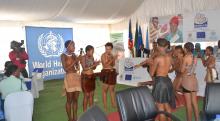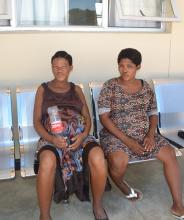The Opening of Lady Pohamba Maternity Waiting Home marks the end of the four year EU funded programme on Maternal and Child Health.
Every year globally, 180-200 million women become pregnant with 287,000 of these resulting in maternal deaths. More than 99% of maternal deaths occur in developing countries and 56% of these deaths are in Sub-Saharan Africa, affecting women living in rural areas and among poorer communities. In Namibia the current estimate of maternal mortality ratio is from the World Health Statistics indicating 265/100,000 per live births. These deaths could be avoided if pregnancy and delivery are attended by skilled health workers at all levels of the health care delivery system.
The Ministry of Health and Social Services, World Health Organization and the European Union initiated a joint partnership programme to accelerate the reduction of maternal and child mortality in Namibia. The programme was launched in 2013 and invested close to € 10 million in skills training of health care providers in emergency obstetric care, maternal and death reviews, provision of equipment including ambulances and strengthening the community health care programme in the 6 districts amongst others.
As the programme comes to the end of its cycle, it witnessed the opening of two additional maternity waiting homes in Opuwo and the Gobabis Health Districts. These two Maternity Waiting homes were constructed under the leadership of the Ministry of Health in partnership with local and regional authorities. With these and other interventions the Government of Namibia, aims to saves lives of women and new -born by addressing the issues of:
- decision-making in being pregnant, availing timely pregnancy and childbirth care addressed by behavioural change health promotion activities and bringing pregnant women nearer to a maternity facility earlier;
- lack of transport and long routes to the health facility by providing ambulances and Maternity Waiting Homes;
- lack of timely adequate care because of lack of skilled birth attendants, doctors and anesthetist, and availability of appropriate equipment at the health facility prior, during and after delivery for both the baby and the mother.
The Deputy Permanent Secretary of the Ministry of Health and Social Services, representing the Honorable Minister at the official inauguration of Lady Pohamba Maternity Waiting Home stressed the importance of preventing maternal deaths. “One women who dies while giving birth is one too many, we need to declare zero tolerance towards maternal mortality’ she said during her keynote address.
Speaking at the same occasion was Namibia’s former First Lady, Madam Penehupifo Pohamba after whom the Waiting Home was named. Madam Pohamba has been a great advocate of maternal care and has championed the establishment of the Maternity Waiting Homes in the Country during her time as First Lady. In her remarks she said that the need for Maternity Waiting Homes was identified ‘because women experienced hardship of travelling long distances to clinics and health centres for the safe deliveries of their babies’. Others would camp near hospitals in the open and ‘were vulnerable to attacks and contracting diseases’ due to unhygienic conditions.
Dr Mary Brantuo, representing the Country Representative, said that ‘the PARMACM Programme has strengthened the Namibian Health System by providing support to all the levels from the community to the tertiary referral facilities. Although the project has come to an end, the mark it has left in terms of infrastructure, equipment, and the capacity of the health providers will continue to sustain the national efforts in improving the lives of mothers and children in Namibia. We need to capitalise on the experiences and lessons learnt in implementing this successful project in charting the way forward.’









